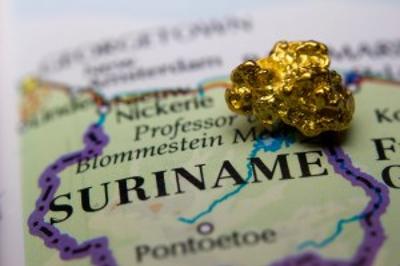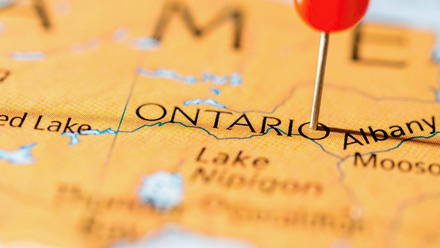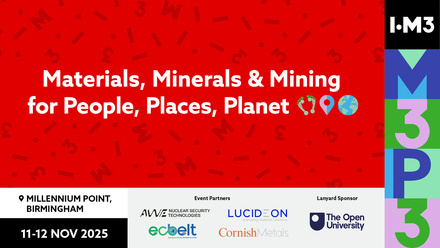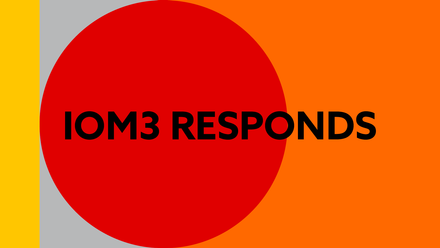Suriname mining profile
Michael Schwartz profiles Suriname, the South American country still riding a gold rush.

Suriname is part of the Guiana Shield, a mineral-rich region whose rocks are pre-Cambrian and comprise a crystalline basement of granitoid and volcanic rocks, along with a gold-rich region referred to as the greenstone belt in eastern Suriname. These rocks were joined to the gold-rich rocks of West Africa prior to splitting apart during the formation of the Atlantic Ocean. The greenstone belt is composed of ancient volcanics and sediments that were heavily deformed about two billion years ago.
The fluids generated by the high temperature and pressure carried gold that was deposited with quartz during faulting, creating a low-pressure zone. From this, Suriname has two major gold mines but remains under-explored due to the deep weathering and jungle cover. Published in 1988, the 25 maps that make up the Suriname Planatlas recorded the following mineral resources among others – primary, alluvial and colluvial gold, oil, bauxite, tin, laterite iron ore, copper and manganese.
The bauxite industry existed for 100 years but is now closed, although bauxite remains in west Suriname. Apache Oil just announced its third oil discovery and soon the country will see increased revenue. Suriname’s economy, however, is dominated by gold mining – it makes up 85% of exports and 27% of government revenues. Mineral price volatility severely affects Suriname’s economy, borne out when the country’s dollar lost 46% of its value between March 2016 and December 2016. At present, a 10% sales tax represents a crucial component of government revenues and is helping tackle the threat of liquidity pressures.
Newmont Suriname
Formerly known as Suriname Gold Company, Newmont Suriname owns 75% of a limited partnership with Staatsolie Maatschappij Suriname NV, Suriname’s state-owned oil company, in operating the country’s Merian Mine. Construction began on Merian in 2014, with commercial production underway on 1 October 2016 – on time and US$150mln under budget. It is an opencast operation located 98km southeast of the country’s capital Paramaribo. Its estimated mine life is between 12-14 years and each year is predicted to yield around 393,000oz of gold.
One area of interest is Newmont Suriname’s relationship with two local communities, the Pamaka and the Kawina. The Pamaka numbers roughly 1,200 and takes into consideration the social effects of the Merian mine, reported under Newmont Suriname’s Environmental and Social Impact Assessment.
Under the agreement, there is preference for the Pamaka in jobs and appropriate products and services, with a complaints procedure and takes into account small-scale mining activities and mercury-free mining.
There is also a commitment to sustainable development through the Community Development Fund established in August 2016. Sustainable projects will be financed by Newmont Suriname, notably in drinking water, electricity supply and agricultural projects. Newmont Suriname is at present still in negotiations with the Kawina community as to how it can benefit from Merian.
In health terms, Newmont works closely with Project CORE, a charity founded in the late 1980s after a consulting assignment commissioned by the President of Brazil. Today, Project CORE operates six warehouses in the USA that collect and distribute more medical supplies to developing countries than any other organisation.
Newmont’s commitment to the charity is $200,000 annually. Last year, nearly 200 people near Merian attended medical clinics and other events. Feedback from projects such as Merian revealed improvements in quality of care and preventative care, more patients treated, expanded capacity to perform procedures and reallocation of budgets to other critical areas such as equipment repair and training.
In the natural habitat too, Merian is witnessing Newmont’s involvement. A 14km² area contains portions of upland and lowland ever-humid forest, more specifically, a rainforest habitat for the tree species Virola surinamensis – endangered baboonwood – and Vouacapoua americana – critically endangered bruinhart. Newmont implemented an internal process for vegetation disturbance to avoid and minimise unnecessary impacts to the two tree species and to natural habitats in general. Even land impacted by small-scale artisanal mining within Merian's right of exploitation is being reforested.
Finally, Newmont has responded to the Church of England’s 10 April 2019 request for information concerning tailings dam management. This disclosure outlines Newmont’s approach to tailings, including communications and risk management, updates to the company’s approach following recent disasters with other companies and an inventory as of 1 July 2019 of tailings dam facilities for operating sites, joint ventures, subsidiaries and legacy sites.
IAMGold’s Rosebel mine
Owned 95% by IAMGold and 5% by the Suriname Government, the Rosebel gold mine lies due south of the capital Paramaribo, within the country’s mineral-rich Brokopondo district. Somewhat closer to the mine is Suriname’s Zanderij International Airport. The mine is accessible via paved and all-weather gravel roads from Paramaribo. Production started in 2004 and had yielded 4.4Moz by the end of 2016.
The Rosebel property contains eight gold deposits over three major structures. The northern trend has a 12km strike length and the southern, a 15km strike length, with the Rosebel deposit located at the eastern extremity of the central trend. Mining at Rosebel has been carried out at eight open pits to date, and is by conventional open pit methods, using excavators and trucks.
Dating from September 2017, a resource estimate for a second mine, namely the Saramacca deposit 25km from Rosebel, shows indicated resources of 14.4Mt hosting an average 2.2 grams per tonne (g/t) making 1.022Moz of gold. Inferred resources total 13.6Mt, averaging 1.18g/t for 518,000oz. Significant potential for expansion at Saramacca has been flagged as the deposit remains open along strike and lies within shallow and softer material. Softer ore for Rosebel is, in turn, an aim of the company’s recent exploration there.
To transport gold ore from the new concession to Rosebel, a haul road is being constructed to cover the 25km distance. In October 2019, however, the first ore from Saramacca was successfully delivered to Rosebel using an alternate road. The new mine is owned 30% by the Suriname Government and 70% by Rosebel, and is scheduled to begin full production in 2020 with an operation time of 15 years.
Rosebel has made substantial contributions to the development of Suriname with several sustainable projects. These feature full sponsorship of the Master’s programme in mineral geosciences
– US$900,000 in total – and scholarships for the best graduates of the MULO-school in Brokopondo, enabling them to attend high school and university in Paramaribo. Rosebel has also committed to a contribution of 0.25% of its gold production to the Suriname Environmental and Mining Foundation.
COVID-19 impact
The Rosebel mine recently resumed milling and diamond drilling operations following the COVID-19 pandemic. Work was given the green light to continue after medical experts from the COVID-19 Outbreak Management Team of Suriname declared it was safe to restart.
Tools were downed on 16 June following union intervention, a move opposed by the mine’s management. However, The Mediation Board for Suriname brokered talks between the two sides and operations resumed in the middle of July.
Rosebel’s management has continued to work to ensure the health and safety of the Rosebel workforce and community since March, justified in that positive cases were confirmed on site in June. COVID-19 protocols are being managed under the guidance of the previously mentioned outbreak management team.
Specifically, the mill at Rosebel has now restarted processing of stockpile material and ore from Saramacca where contractors have also resumed construction to complete road access in the district.
IAMGold’s recent statement acknowledges that with ‘the ongoing uncertainty relating to the duration and extent of the global COVID-19 crisis, and the impact it may have on the demand and price for gold, on our suppliers and workforce, and on global financial markets, the company continues to face uncertainties that may impact its operating activities and financial results’.
Expert view
Dr Dennis LaPoint is a registered professional geologist with over 40 years’ experience, half of which in Suriname. His achievements include discovering Alcoa’s Nassau gold district – now a major mine by Newmont – and exploring for more deposits at Rosebel gold mine in his role as Exploration Manager for Cambior which became IAMGold. Here he shares some thoughts with Materials World.
On the subject of obtaining permission for mining projects in Suriname, LaPoint is positive. ‘The government is very supportive and the current mining laws are flexible. After obtaining exploitation rights, you have permission to mine. An international company should follow best practices for the environment and community involvement. Besides exploitation rights for a major mine, the company can negotiate a mineral agreement that is approved by the government. Newmont and IAMGold have each obtained such an agreement that spells out tax and employment benefits. The current mining law was prepared in 1958 and there have been efforts to update for an agreement that better protects the environment and local people.’
Artisanal mining in the country, LaPoint explains, is accepted and pays its way but requires regulation. ‘Of course, much of the gold production is from such operations. Suriname is part of a regional gold rush where all-terrain vehicles have replaced mules. Like any developing country, small-scale mining is essential to the economy, but the miners use mercury and that is very destructive.
‘Stronger leadership and action by the government are needed to eliminate the use of mercury as well as protect the ecosystem in terms of loss of wildlife and the suspended sediment load in creeks and rivers. Rosebel has issues as there is a local village on a mining concession. They try to work together – sometimes it works, other times not. Newmont, being more remote, has seemed to control the situation better. During exploration, the miners and companies can co-exist and artisanal mining is not usually an issue in terms of safety.’
While non-gold resources exist in Suriname, LaPoint says their infrastructure is poor, they lie in remote areas and need to be attractive to investors. He describes diamonds as ‘hot’, but there is no clear mechanism for exploration. Copper and speciality metals are also present, with bauxite being ‘big’ for 100 years and still in place. The resources need investors with patience.
Several other issues are present. While location of the mining site comes into play, electric and water supply are ‘likely an issue’. Then there is the thorny issue of working with indigenous peoples. LaPoint is direct in his solution, ‘Patience.’
Summing up his overall memories of working in Suriname, LaPoint muses, ‘Well I am here and have been here 20 years. Yes, favourable for exploration and mining. Probably the best in South America.’
Did you know?
- Suriname is one of the smallest countries in South America, yet its population is one of the most ethnically diverse in the region.
- Dutch is the official language of Suriname.
- Some two-fifths of Suriname's population is concentrated in the capital, Paramaribo, and its surrounding area.
- The southern four-fifths of Suriname is almost entirely covered with tropical rainforest.
Source: Brittanica







